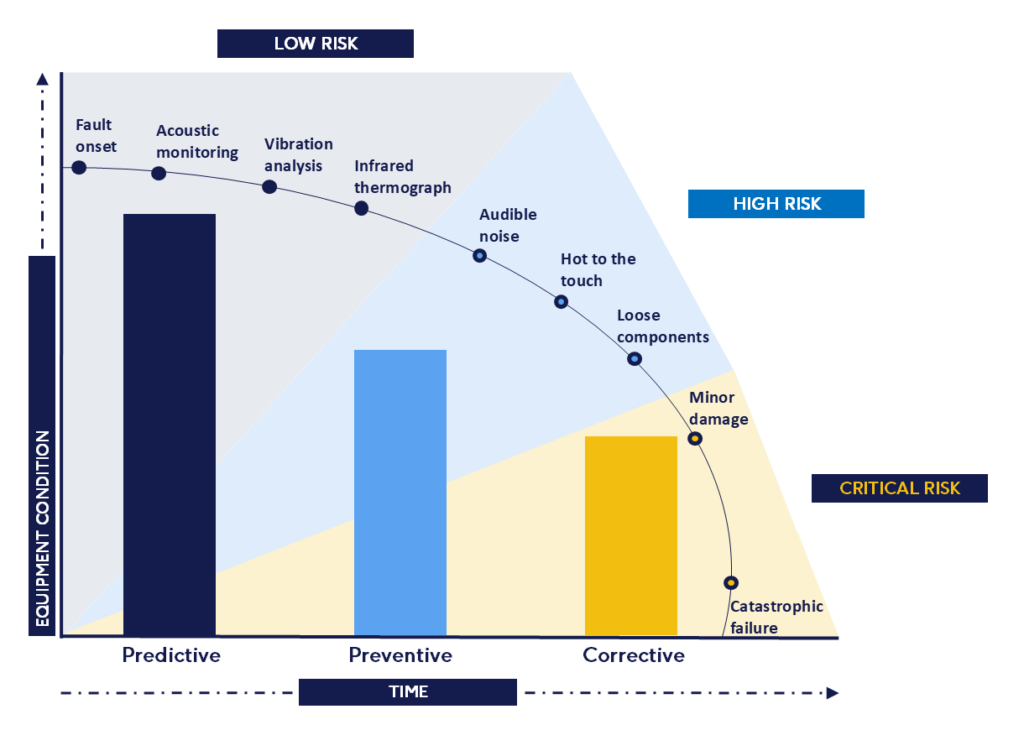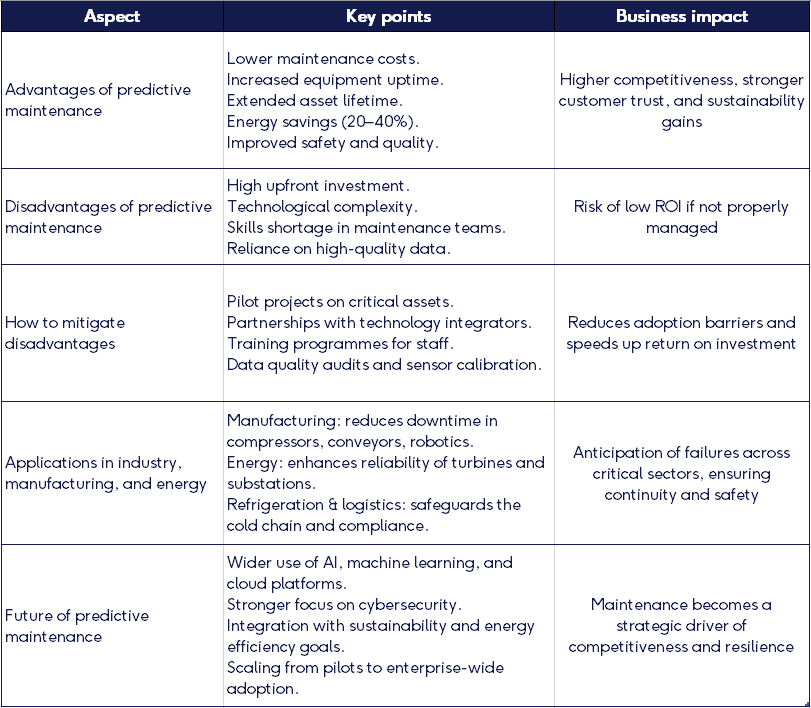In the food, logistics, and retail industries, every minute of downtime in a production line or refrigeration system can result in significant financial losses. A failure in the cold chain, the stoppage of a freezing tunnel, or a malfunction in warehouse climate control systems can compromise both food safety and customer trust. Industrial predictive maintenance emerges as a strategic tool to anticipate failures and schedule interventions with maximum efficiency. Today, it is no longer an exclusive practice of large corporations but an increasingly accessible solution for medium-sized companies striving for competitiveness.
Predictive maintenance is a key lever to improve competitiveness, reduce failures and optimise costs. For real, sector-based applications, see our examples of predictive maintenance, showing how PdM is applied in industrial refrigeration, packaging, logistics and retail.
What is predictive maintenance?
Industrial predictive maintenance refers to a maintenance strategy based on real-time monitoring and advanced data analytics to predict when equipment will fail. Unlike preventive maintenance, which is scheduled according to predefined intervals, predictive maintenance relies on actual equipment condition and performance indicators.
The goal is not only to avoid unexpected breakdowns but also to optimise maintenance schedules, extending the useful life of assets and ensuring operational continuity. Industrial predictive maintenance is particularly relevant in industries where downtime translates into millions in lost revenue, reputational damage, or safety risks.
In practical terms, predictive maintenance is supported by technologies such as:
- IoT sensors monitoring vibration, temperature, and energy consumption.
- Data analytics and machine learning models capable of forecasting anomalies.
- Digital twins that replicate real equipment to simulate different operating scenarios.
This proactive approach allows organisations to intervene only when necessary, reducing both maintenance costs and the risk of catastrophic failures.
Difference between preventive and predictive maintenance
In the industrial context, understanding the difference between predictive, preventive and corrective maintenance is essential to defining a reliability strategy.
The chart illustrates how a fault develops from its earliest signs to a catastrophic breakdown, and how each maintenance strategy intervenes at different points along that curve.
Predictive maintenance acts in the initial phases, when risk is still low and operational condition can be kept stable.
Preventive maintenance takes place at an intermediate stage, before failures become critical, although it may require scheduled equipment shutdowns.
Corrective maintenance is applied when damage is already visible and risk is at its highest. The earlier action is taken on the curve, the lower the risk and the greater the savings in cost and safety.
“For a broader classification of all maintenance approaches and a detailed comparison between them, you can refer to our article on types of industrial maintenance.”
Advantages of predictive maintenance
The advantages of predictive maintenance are evident when compared to preventive or corrective strategies:
- Cost reduction: Lower spare parts usage, fewer emergency repairs, and extended asset lifespans.
- Increased availability: Higher machine uptime and better production planning.
- Energy efficiency: Continuous monitoring detects inefficiencies, helping reduce energy consumption by 20–40% in refrigeration and industrial processes (source: European Commission – Energy Efficiency in Industry).
- Improved safety: Early detection of anomalies minimises risks for operators and prevents hazardous failures.
- Quality assurance: Stable conditions in production processes, particularly in food manufacturing, improve final product quality and reduce waste.
For CEOs and operations managers, these benefits directly impact competitiveness, customer satisfaction, and sustainability. Industrial predictive maintenance reinforces these advantages by linking real-time operational data with strategic business goals.
Disadvantages of predictive maintenance
Despite its benefits, there are still disadvantages of predictive maintenance that companies must address:
- High initial investment: The implementation of sensors, software platforms, and integration requires significant capital.
- Complexity: The need for reliable data management and advanced analytics may overwhelm teams unfamiliar with digital tools.
- Skills gap: Maintenance staff must be trained to interpret data and work with new technologies.
- Dependence on data quality: Inaccurate or incomplete data can lead to false predictions and poor decision-making.
How to mitigate these disadvantages
- Start with pilot projects on critical equipment before scaling.
- Collaborate with technology integrators that provide turnkey solutions.
- Develop training programmes to close the digital skills gap in maintenance teams.
- Establish regular audits of data quality and sensor calibration.
By applying these measures, companies can progressively reduce barriers and accelerate the return on investment. In this sense, industrial predictive maintenance strategies must be seen not just as technical upgrades but as organisational transformations.
“Scaling industrial predictive maintenance requires more than advanced algorithms — it involves cultural change, strategic asset selection and strong data governance. McKinsey outlines five ‘golden rules’ to achieve this effectively, from choosing the right assets to integrating PdM into the digital ecosystem (McKinsey, Prediction at scale).”
Predictive maintenance in industry, manufacturing and the energy sector
When discussing predictive maintenance in industry, it is useful to adapt the concept to each sector:
- Predictive maintenance in manufacturing: Focuses on machinery such as conveyors, compressors, and robotics. Monitoring vibration, lubrication, and energy consumption avoids costly production stoppages.
- Predictive maintenance in the energy sector: Applied to turbines, substations, and renewable energy assets. Detecting anomalies in real time improves safety and ensures continuity of energy supply.
- Predictive maintenance in refrigeration and logistics: Critical in food retail, where cold chain integrity ensures both product safety and regulatory compliance.
Although each industry applies different technologies and has unique priorities, the common factor is the use of real-time data and predictive analytics to anticipate failures. Integrating these perspectives under industrial predictive maintenance helps unify strategies across sectors, aligning operational efficiency with business resilience.
Future of predictive maintenance
Looking ahead, the future of predictive maintenance will be shaped by greater integration of artificial intelligence, machine learning, and cloud-based platforms. The key predictive maintenance challenges will include:
- Managing increasingly large and complex data sets.
- Ensuring cybersecurity in connected environments.
- Aligning predictive strategies with sustainability goals, reducing energy waste and emissions.
- Scaling solutions from pilot projects to entire facilities.
The evolution towards Industry 4.0 and Industry 5.0 places industrial predictive maintenance at the heart of smart factories, where digital technologies converge to ensure maximum efficiency and resilience.
Executive summary of predictive maintenance
Conclusion: from cost centre to strategic value driver
Industrial predictive maintenance has evolved from being perceived as a costly option to becoming a strategic enabler of competitiveness, sustainability, and customer trust. By anticipating failures, optimising energy use, and safeguarding production continuity, it transforms maintenance from a cost centre into a generator of strategic value.
For directors and CEOs, the message is clear: investing in predictive maintenance is no longer optional—it is the cornerstone of long-term resilience in an increasingly competitive industrial landscape.
Will you prepare for change? Discover how to implement predictive maintenance in your industry.





